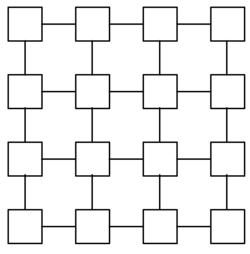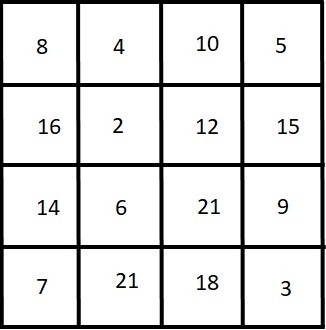Inspired by Calvin LIn and Chung Kevin

Use 16 distinct positive integers to fill up the grid, such that the integers in any two connected squares have a greatest common divisor that is greater than 1.
What is the smallest possible value of the largest positive integer used?
The answer is 21.
This section requires Javascript.
You are seeing this because something didn't load right. We suggest you, (a) try
refreshing the page, (b) enabling javascript if it is disabled on your browser and,
finally, (c)
loading the
non-javascript version of this page
. We're sorry about the hassle.
2 solutions
There are other numbers than 6 in our list that have factors common with both 1 4 and 2 1 , such as 1 2 and 1 8 . Here is another arrangement: 8 1 6 1 4 7 2 4 1 2 2 1 2 0 1 0 6 9 5 1 5 1 8 3
Log in to reply
Thanks for pointing that out. I have edited my comments accordingly.
the strategy is to push odd number to the corners.
As, Mr. Brian Charlesworth has proven that the smallest maximum integer for the grid is 2 1 , another valid grid solution is

To establish an upper bound, note that we could use the first 16 positive even integers in any configuration, in which case the gcd of adjacent numbers will always exceed 1. This gives us an upper bound of 3 2 for the smallest maximum. Also, we cannot include 1 , as the gcd of it and any other positive integer will be 1. Thus at best we would be using the integers 2 through 1 7 .
However, consider what happens with primes ≥ 1 1 . Each square is adjacent to at least two other squares, so any number included must have two other numbers with which it shares a non-unit gcd. With 1 1 , we would have to include 2 2 and 3 3 at best, but as we know 3 2 is an upper bound we know 1 1 cannot be part of an optimal solution. The same goes for 1 3 , 1 7 and 1 9 . So now the best we can do is to find a solution that involves the first 16 positive integers greater than 1 and excluding 1 1 , 1 3 , 1 7 and 1 9 . These 16 will be
2 , 3 , 4 , 5 , 6 , 7 , 8 , 9 , 1 0 , 1 2 , 1 4 , 1 5 , 1 6 , 1 8 , 2 0 , 2 1 .
So if we can create a suitable grid with these 16 integers then the smallest maximum will be 2 1 . And here is a valid solution grid:
5 1 0 1 4 7
2 0 2 6 2 1
4 8 1 2 1 5
1 6 1 8 9 3
Notes: 7 has to be placed in a corner as it has non-unit gcd's with only 1 4 and 2 1 . This forces the placement of 1 4 and 2 1 . The remaining integers in our list that have a non-unit gcd with both 1 4 and 2 1 are 6 , 1 2 and 1 8 . Each of these has prime factors 2 and 3 only, so it makes no difference which we choose, so we'll go with 6 . 3 and 5 , being primes, are trouble, so we place them in opposite corners, after which we place 9 and 1 5 adjacent to 3 , followed by placing 1 0 and 2 0 adjacent to 5 . This forces the placement of 1 2 and 1 8 in the remaining squares adjacent to 9 , with the placement of 1 2 also taking care of 1 5 . Then we're home-free, placing the last four evens in any order in the last four squares. There are other solutions possible but this was the one that seemed most apparent.